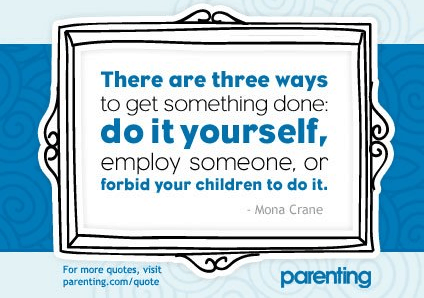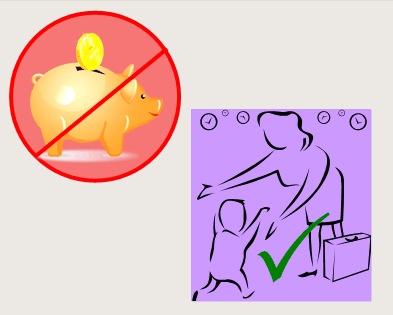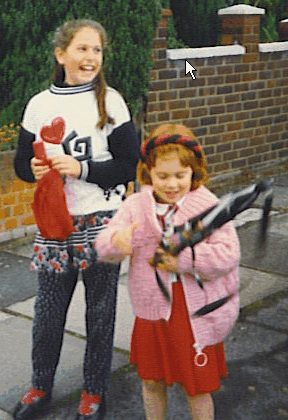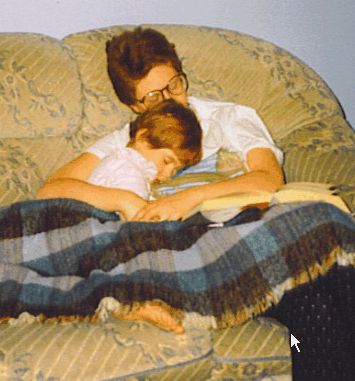
Parenting is a
rewarding but difficult job. Here are 10 tips (all original content) from a parent, now
grandparent, to make the job somewhat less difficult and a lot more
rewarding.
There are two options for reading:
Option 1: Scroll down the page.
Option
2: The Table of Contents is organized as a list of hyperlinks. Simple
click on the topic of interest to jump to the section. At the end of
each section, click on "Back to Table of Contents" to jump back.
note - all pictures on this site have been taken from free sites. masks have been used to protect the "not so innocent". however, if anything offends anyone, just drop me a line being specific as to which pic and why and it's gone.
Table of Contents
Don’t Promise/Threaten What You Can’t Fulfill & Don’t Ask Questions That You Don’t Really Want the Answer To
Some Answers to “Why” – When There Really is No Answer Except “because I said so”
This book developed out of a great love for children and a great sympathy for their parents. Too often I would see both sides frustrated or angry as a result of some event in the process of “raising children” and I would think, “If parents would just follow a few basic procedures, it wouldn’t have to be that way.”
So, following, are ten simple commandments to raise children by. No matter what issues one wishes to teach, whether one has boys or girls, or whether one stays at home or works outside, these principles will work. They will produce balanced, loved, mature, responsible, playful, capable children who will become adults any parent can be proud of.
Throughout all of this, remember that no goal that is complex can be reached overnight. There are no short cuts. Time and patience are essential. Be confident and you will succeed. Time and patience.

By being consistent about behavior, we settle our children into behavior routines. As children learn what we will allow when, they start to build patterns of acceptable behavior and follow them. Since the children are behaving mostly according to our standards, many unnecessary fights about behavior are prevented. Also, these logical behavior patterns become a habit, creating adults that behave in correct and positive ways.
In order to be consistent, we must think about each situation with full attention at that moment. The first time a situation occurs, we need to analyze what pattern we want to begin building and act accordingly. The next time a similar situation occurs, we should
remember the times before.
see what is the same and what is different.
base our response on that.
If all is the same, the child should get the same response. If there are differences, we should give our response and explain to our child how come the response is different from the last time.
-----------------------------------
Example
Mom and Young Child are in the supermarket. It is close to mealtime, and the child wants to eat a chocolate bar.
What are the important points for Mom to consider in this situation?
First, the child probably IS hungry.
Second, Mom might prefer the child to eat a meal before a sweet.
Third, Mom has the feeling that the child will make a scene in the supermarket if he doesn’t get the chocolate bar. Since the supermarket is a public place, such a scene would be highly embarrassing,
Mom must decide which of the above points is the most important to her. If she ALWAYS does not want a scene in a public place, then the child must eat the chocolate bar. However, that then must ALWAYS be the rule and the child should ALWAYS get what he wants without a fight – chocolate bar, toy, etc. If she ALWAYS wants the child to eat a meal first, then the child must ALWAYS wait, even it means tears and screams.
The point here is that once you decide on a path to take, you must stay on that path. It is no good giving the child the chocolate bar in the supermarket to keep him quiet (because on that day we have no patience for public scenes), and then deny the child the chocolate bar at the restaurant on another occasion because we happen to be full of patience that evening.
Depending on the decision, Mom’s answer will vary. Several choices are:
“Here’s the chocolate bar.”
“It is almost mealtime and you need to eat a meal first. We’ll buy the chocolate bar and keep it till after. Then you can eat it.”
“You need to eat your meal before your sweet but I know you are hungry. You can have an apple/banana/breadstick to fill your hungry tummy.”
-----------------------------------
Example
On a previous evening Teen has asked Dad for the keys to the car and received them. This evening Teen asks Dad for the keys.
On the surface, this evening seems like the previous evening so Teen is expecting the keys. However, Dad may have things on his mind. Perhaps he does not want Teen to feel that each time she asks for the keys to the car she will get them. Perhaps Dad was thinking of using the car himself to go out. Even a third could be that Dad has just seen a program about alcohol and driving accidents and is in a fearful mood.
Dad should communicate his thoughts when he gives his answer. Following are some of the directions that this answer could take:
“Last time you asked I said, “Yes”, right? (Teen nods.) The thing is, I don’t want you to feel that every time you ask the answer will automatically be “Yes”. I want you to learn to think about how often you need to use the car and when you can make other arrangements. That way, when you do ask, I will know it is really important and I will really try to let you use the car. So how is it this time?” Then a discussion could begin about how to arrange car usage, with even an agreed usage per week being arrived at to help matters in future.
“If my friend calls, we will go out and it’s my turn to drive so I think not tonight.” If Teen responds that it is really important, Dad can decide if he wants to let Teen drop off and collect him and his friend or just stick to his “No”.
“You know, I just saw a program on drinking and driving. I’m not saying you are drinking, but do you know how many people are victims of accidents where someone was drinking? It really scared me and I’m feeling like saying “No” to you because I love you and want to protect you.” This is a good opening for a talk about this very important concern and if Dad feels reassured at the end, he will probably agree to give the keys.
-----------------------------------
By explaining our answers, not just limiting them to “yes” and “no”, several advantages are gained. In order to give a sensible explanation, we have to review the situation including comparing it with times before. This helps us to be consistent. Also, our children learn the background to our decisions. This helps them to understand, and thus better accept, our rules. It follows then that as they know how we think about things, it is very clear to them how they should behave. Do not feel, however, that this explanation is a justification or defense. Nor does it mean weakness on your part. You are only giving information, not asking for permission.
don’t promise/threaten what you can’t fulfill
and
don’t ask questions that you don’t really want the answer to
A popular trick in the card game Poker is to bluff. As parents, we must never promise/threaten what we can’t fulfill so that when our child calls our bluff, she learns that we always follow through. If it is a good thing, like an ice cream after dinner, we must provide it. If it is a bad think like leaving the restaurant in the middle of a meal if the child throws food again, we must carry it out. If we truly bluff, our child quickly learns that we are full of “bark but no bite”. In the case of a nice promise, the child becomes needlessly disappointed. This often leads to tearful fights with you – “You promised … you said …you… .” In the case of a threat, the child learns to pay no attention to her parent since she has learned that nothing will really happen.
To avoid being trapped, we must phrase our promises/threats carefully. For nice things, we can say “I will try very hard to… If I have time …” or some other words that mean that we know it is important and we will work our best to fulfill the wish but it may not happen. For threats, we can say “If you do such-and-such I may have to … I’m sure you wouldn’t want me to do such-and-such so let’s behave properly” or some group of words that says what will happen but doesn’t say exactly when it is going to happen, leaving you flexible.
-----------------------------------
Example
A new children’s film has come to the movie theaters. The children ask Dad to take them.
Dad would like to take the children to see the movie, but he doesn’t know what his work schedule will be. On the one hand, he wants to make a commitment. On the other hand, he doesn’t want to make an arrangement he might not be able to keep.
In situations such as these, parents get caught between the child’s short term gain vs. long term gain. We are inclined to immediately say “Yes” so that our child will feel good. However, that happiness is only for the moment as the child is still waiting for us to deliver on our promise. If we are non-committal, our child is neither glad nor disappointed (or if so, only for a short time) because there has been no answer either way. In the case of a broken promise, the hurt of not getting what was promised remains in the child’s memory for a very long time, far outweighing any short-term happiness from that quick “Yes”.
To handle this, Dad should find out how long the movie will be showing.
If Dad is sure that he can find a day to go before the movie leaves the movie theater, he can say, “We will go to the movies but I’m not sure which day.” If there is even a ghost of a chance that he might not be able to manage it, Dad can leave it even looser by answering, “You want to go and I want to take you. My days are pretty busy just now, and I’m not sure how things will work out. I am going to try very hard to arrange some time so we can go but you have to realize that we might not get there this time.” In this case, even if the children are disappointed by not going, they will not have the added anger and frustration of a broken promise as well.
-----------------------------------
A related issue is not to ask questions that you really don’t want the child to answer. Perhaps the favorite one is “Don’t you think it is time to go to bed now?” If the child says “Yes” then take his temperature! When you get the normal response of “No”, what do you do? A situation has been created where the child has said what he prefers and now you have to convince him that he is wrong and you are right. This is not fun as we all know.
If an action has to be taken, instead of questions, state the action clearly, and encourage the child to perform it. Simple statements of action are much easier for the child to accept – as no one has asked him his preferences, he doesn’t feel obliged to protest in order to defend his personal integrity.
-----------------------------------
Example
Mom decides that it is time for her young son to go to bed. He needs to put on his pajamas and brush his teeth.
In order to arrange things well, Mom should consider:
First, is her son able to do all of this by himself at one time? Sometimes, giving children too long of a job makes them feel overwhelmed. They feel it is too big of a mountain for them to climb. So Mom might divide the task in two.
Secondly, how long does Mom want to give her child to finish the work? The time needs to be enough for the child not to feel under too much pressure without the project going on all night.
There are many ways to approach this situation. Following are two.
All tasks together
Mom: Time to go to bed now.
Son: Do I have to?
Mom: Yes. If you are finished in 20 minutes, I will read you a story. Come, let me show you what 20 minutes looks like on the clock.
(Every house with young children should have at least one clock with hands. Digital clocks are difficult for young children because they cannot tell how close they are getting to their deadline.)
If Mom wishes, she can remind the child every 5 minutes how much time is left but without anger or threats. If he does not finish in time, no book is read. Mom can leave him to finish or put him to bed as he is – pajamas or not, teeth brushed or not. In either case, Mom should remark something like “I’m really sad you didn’t finish in time because I was really looking forward to reading to you. Maybe next time…” this magnifies the feeling of sorrow that the child has and helps to encourage him to do better in future.
Dividing the tasks
Mom: Time to go to bed now.
Son: Do I have to?
Mom: Yes. Everyone has their work to do and now this is yours. You need to put on your pajamas and brush your teeth. Can you do all that?
If the child says “Yes”, all well and good. If not –
Mom: First, put on your pajamas. Then come down and we’ll sing three songs together.
After that is accomplished –
Mom: Now it is time for bed. You put on your pajamas so well! Let’s see if you can do your teeth nicely too. Come on, up we go!
emotional reinforcement over material reinforcement
Better incomes and the low cost of many children’s things mean that we can buy much more for our children than our parents could for us. It is natural to want the best for our children, and it is natural to want to make their life full of lovely things. What we don’t want to do is get into the trap of rewarding behavior with material items.
Using “things” as rewards for good behavior is full of problems. As the child gets older, the things that she wants usually get more expensive. What was not a strain on the family budget quickly becomes one. Also, expecting a material reward for good behavior means that if nothing comes, the good behavior will also not come. Thirdly, a child that is used to material rewards will generally become an adult that is used to material rewards. As adults, we cannot always give ourselves, or have given to us, those items that we would like – new car, bigger house, more jewelry, designer clothes. This can lead to frustration and even bad behavior in an attempt to get those material things that we have learned to crave.
Behaving well should be its own reward. It is part of what good members of our society do. It is what is expected of us as caring family members. The child should be made to feel that his good behavior is a credit to himself, his family, his society, and that that is the gain. If he does not behave well, he should be made to feel that he has not only disappointed his parents and family but that he has disappointed himself. Giving lots of praise for good behavior and sad/angry looks and words for bad behavior are very meaningful to the child. Children want to be seen as “good”. They want to hear nice things from their parents about how wonderful they were. Everyone likes to show off a bit about their accomplishments and children are no exception.

-----------------------------------
Example
My child, then 6, was misbehaving at school. She talked when it was work time. Her work was not suffering but she disrupted the other children. The teacher tried scolding, seating my daughter apart from the others, and sending her to a lower class to work, i.e. “If you’re going to act like a baby…” I suggested not letting the child participate in classroom activities whenever she misbehaved. None of these worked.
Her dad came up with the solution by purchasing a day-by-day pocket calendar. The teacher agreed to note the child’s behavior every day in the space given. Every day her dad and I separately read the comment and we both gave either praise or sad words. At the end of each week, a colored star was given for a perfect week, and a “smiley” was drawn for a so-so week. After 2 months the book was reduced to Fridays-only, for a weekly evaluation, AT MY DAUGHTER’S REQUEST. She said, “I don’t need it every day. I can manage.” Soon after, the calendar was not necessary at all.
I asked my daughter why this solution worked. She said
the diary was the means to get lots of daily praise.
she felt important to have a diary which others didn’t have – even though most adults would see it as a negative thing. She felt special.
Don’t think that it was easy for my daughter to change her behavior. The first few weeks were bad. It took time for the routine of good behavior to be established.
There are times, however, when parents may trade one behavior for another as a reward. An example is, “If you let Daddy finish his newspaper by sitting quietly for five minutes, I will read you a book.” This encourages a spirit of cooperation which is healthy and often used in the adult world to encourage our peers to behave in a way that we wish.
you don’t have to be right all the time

There are times when it pays to be wrong. Frequently, with younger children, they get to a stage where they have to be right. Whether it comes from asserting their independence or just plain stubbornness, you may choose to let the child’s point of view end the discussion.
Assuming the issue is a minor one, several advantages are gained by doing this.
A long, drawn-out fight over a little thing is avoided.
The child feels he has gained over you which is good for his ego.
The child feels that he has been listened to and thus is more likely to listen to you the next time.
You can use this incident during a future fight, i.e. “Remember the other time when you were right and I was wrong? Well, no one is right all the time. Perhaps this time you are the one who isn’t right.”
-----------------------------------
Example
Dad is getting his son dressed to go to the park. After Dad laces up his son’s shoes, the child starts complaining that he has tied the shoes too tightly.
Obviously, in order to go out, the child must have his shoes on. The laces must be tied tight enough that the shoes will not fall off. However, between loose and tight there is room for maneuver.
Also, the laces may not be uncomfortable at all. Rather the child sees the opportunity to assert control over his dad. Dad must decide if the issue is important enough to fight over. We know as parents that we cannot argue over every incident every day – we would get nothing else done! It is usually better to triumph in a few key battles than to win every skirmish.
In this case, Dad decides that he will let this one go without a fight. Dad’s response to his son could be:
“Oh dear! Are they? Here – I hope that’s better.” (re-tying the laces a fraction looser)
“Silly me! You see – even parents sometimes make mistakes. I will pull the laces and you tell me when they are tight enough.”
“Never mind. Let’s try again.” (re-tying the laces exactly the same as before. If the child notices, you will have to make them looser. If not …)
-----------------------------------
Often, as our children become older, the issue becomes more important. While still not dangerous, the child’s opinion is definitely less correct than the parent’s. Here, we much weigh the value of making the child follow our ideas vs. maintaining a positive relationship. Again, as with the younger child, we gain long-term advantages by being reasonable and not always demanding to be the one who “wins” the disagreement. What the child does not realize, is that we have carefully calculated where it is in our best interest to “lose”.
-----------------------------------
Example
If you have an older child, you can see this scene in front of you:
Your family is going to eat out with friends. While the restaurant’s only dress code is no bare feet, people are usually quite dressed up when they eat there. You ask your teenage daughter what she is wearing, and she responds, “My best jeans and sweater.”
To you, the jeans and sweater in question are fine for everyday but not what you had in mind for going out to eat. You know that your daughter feels these are “good clothes”. Since the restaurant will allow such an outfit, there is no real problem except within yourself. You feel your friends and others will be critical of you for allowing your child to “dress like that”.
You can force your daughter to wear “more suitable clothes”. Do you gain? By allowing her idea to stand, another time when it truly makes a difference what is worn, your daughter will be more easily convinced to change her idea as you are not always “on her back”.
You decide to “lose”, turning it to your advantage by saying something like, “I’m really pleased that are wearing something you consider suitable for a restaurant. You are becoming a really responsible person.” Your daughter feels very pleased at the compliment and at not having been hassled.
you can’t do everything at once –
concentrate on the big issues
The phrase “Jack of all trades, Master of none” describes the parent who tries to do everything at once. Nothing gets accomplished expertly. Also, if we constantly remind our child what to do, our voice quickly fades into the background and is “tuned out”. Better to work on a few issues and finish with them. Then pick a few more.

Concentrating on too many things at once might make you feel...well...slightly confused.
-----------------------------------
Example
A young child is having dinner. He is throwing the carrots on the floor but is eating the potatoes and peas.
The behaviors his parents are currently working on are eating nicely and toilet training. Thus, the parent should only correct food throwing. The fact that the carrots may not be eaten must be accepted. Eating what’s on one’s plate is a different behavior which has not been picked at this time.
To correct his behavior the child’s
parent could say, “It’s not our custom to throw food on the floor.” shaking head “No”. A different response might be, “No
– eating nicely means no throwing food on the floor.” If the
child stops throwing the carrots, his parent should consider the meal
to have been a success.
floor.” shaking head “No”. A different response might be, “No
– eating nicely means no throwing food on the floor.” If the
child stops throwing the carrots, his parent should consider the meal
to have been a success.
-----------------------------------
As the big issues are dealt with and the child sees himself as a responsible individual, many minor behaviors will fix themselves. The more a person feels that he is well-behaved, the better behaved he becomes. It is like a self-fulfilling prophecy.
-----------------------------------
Example
How many of us have older children who continually leave their things around the house? Shoes line the entrance. Coats are slung over living room chairs. Schoolbooks are on most tables.
Why are we bothered? One reason is definitely tidiness of the home. This behavior causes a waste of time to the house cleaner that could be better used elsewhere. Another reason might be that we wish to teach our children to look properly after their things. Lastly, could be that our children should respect others’ wishes. They should learn that if their actions are bothering someone, especially a family member, they should seriously consider stopping.
Obviously, most of the comments that could be made, such as “Pick these up at once!” or “I don’t want to see your things lying around here any more!”, have been made by this point. Thus, a more long-term solution needs to be considered. One such scheme is the following:
On Monday, Dad decides that he will work on this one big behavior. Dad tells Teen that picking up Teen’s things take time away from things Dad needs to do. So from now on, each item left around the house after Teen’s bedtime will be dumped on Teen’s bedroom floor and will count as 10 minutes of extra help to Dad on the weekend to pay back that time. Thereafter, each evening, once Teen has gone to bed, Dad makes the rounds, collects the items, writes down how many there were, and dumps them on the bedroom floor. There are no angry words, no discussions. Each weekend the total number of items is multiplied by 10 minutes. Then a task(s) is given to fill that time. Dad makes sure that this task(s) is done before Teen is allowed to go out or do his own things.
If this solution is chosen, then Teen’s bedroom floor could gradually become quite messy if each day’s “collection” is dumped on it and not put away. In the case that this happens, the disorganized room should not be commented on – as much as it bothers the parent. A clean Teen bedroom is not the target at this time so let it be.
Another idea is one that we used
when my children were around 11 and 7 years old. Instead of dumping
the items on their bedroom floor, the things went into a big plastic
garbage bag. On the weekend, each child was allowed to “ransom”
one item. Things that got into the bag were not only toys, but also
school clothes and books. It was hard to put those things into the
bag knowing that we might be causing our children problems at school.
However, if a solution is to work, it must be stuck to. In fact,
after a week or two, no school clothes or books lay around the house
after bedtime. In quite a short time after that, no toys and games
did either. However, the children were ransoming items for months to
come.
teach your child to think for herself
Imagine yourself in a maze. At every turn, your correct decision brings you an easy walk to the next turning. Every wrong decision brings some horrible happening that plagues you until you reach the next turning. Perhaps you get yourself into such a terrible state that you never reach the next turning.
What is your state of mind? If you have never been in a maze before, you might feel very confused, helpless, blind, like the world is falling in on you. On the other hand, the more experience you have had in mazes, the better you will handle this one. You will see the similarities; have some idea of how to adjust to the differences, and overall be in a better position to cope – even if your next decision brings a mud fall onto your head.
Learning to make good decisions is a slow, gradual process. To prepare them for the complicated task of adult decision making, it is critical that children be taught to think for themselves. We need to allow them to practice by making decisions appropriate to their stage of life. This does mean that sometimes they will not follow the path we would have chosen for them. Unless their choice is a dangerous one, we must let that happen. In helping them to make these decisions, we can set boundaries or constraints just as adults have limits on their decision possibilities.
-----------------------------------
Example
In schools where there is no uniform, children must decide what to wear five mornings a week. We, as responsible parents, may wish to remain in control in order to see that our child wears the right clothing. Our child, now a “school-goer”, wants to proclaim her independence by choosing the clothing she thinks is correct. How can we avoid these daily hassles and use this situation to teach our child decision making?
Idea 1: The parent and the
child alternate the mornings. On Monday the parent picks the clothes,
and the child must accept them. On Tuesday the child picks the
clothes, and the parent must accept them.

These well-dressed young ladies have coordinated their lovely outfits by themselves.
Idea 2: The parent takes clothes appropriate to the occasion and season and puts them in a special place or particular drawer. The parent tells the child to choose from these “school clothes”. When the child comes down one morning wearing a striped shirt in orange and blue and patterned trousers in green and red, nothing should be said regarding clothes matching as long as the clothes come from the school clothes. If the child asks how they look, the parent should say something complimentary.-----------------------------------
Example
The clothes for school situation can apply to older children as well. I remember my teenage younger sister arguing with our mother about her school wardrobe. My mother remembered that
children should be making decisions appropriate to their stage of life.
teens are close to adulthood where budgeting and value-for-money are real concerns.
Her solution incorporated these items, giving my sister vital experience in these crucial areas.
My sister was encouraged to begin buying her clothes – which is what she wanted anyway. An overall budget was established as well as a clothes list showing how many of each items was to be bought and the cost of that item. For example, 2 pairs of jeans at $X each or 2 pairs of jeans – one regular at $X and one fancy at $2X. Much discussion of what should be on the list, such as a warm coat, was needed as well as what was not allowed. Then my mom let my sister begin to buy. Sometimes my sister found an item for less money than what had been allocated. She then had more to use on another item or buy something that wasn’t on her list. Going over budget was not allowed unless my mother and sister discussed it first. When the purchases were brought home, my mother was supportive and not critical as long as her pre-conditions had been met. At the beginning, my sister did not always choose the best items. Sometimes seams opened quickly. Sometimes garments shrank or their colors ran together in the laundry. However, she soon became wiser. Today, as an adult wife and mother, she is one of the most careful shoppers I know. This skill has enabled her to get her family successfully through some tough financial times.
-----------------------------------
 Often parents complain that
“So-and-so is influencing my child in a bad way” or “My child
wouldn’t be naughty if it weren’t for So-and-so who encourages
him”. There will always be negative influences in a person’s
life. It is impossible to remove all of them. It is essential to
learn to resist negative influences and stay on the right path.
Often parents complain that
“So-and-so is influencing my child in a bad way” or “My child
wouldn’t be naughty if it weren’t for So-and-so who encourages
him”. There will always be negative influences in a person’s
life. It is impossible to remove all of them. It is essential to
learn to resist negative influences and stay on the right path.
-----------------------------------
Example
Your neighbor is at her wits end. She tells you of her son who is usually a quiet, well-behaved person. Another boy, in the son’s class, is noisy and rude. The children have become friends. Now the son is behaving in a noisy and rude manner.
This is a hard situation. For one thing, what may be noisy and rude to one person may not be to another. Thus, it is not realistic to expect that others will always care to fix their child’s behavior. Also, your neighbor cannot herself, nor expect the teachers, to stand guard every second to prevent the two children from interacting. Lastly, this is only one incident. There are plenty of other children in class, school, and the neighborhood who will try to influence your neighbor’s son.
We assume that the behavior of your neighbor’s son is now above what she considers acceptable. Your neighbor can punish her son or remove him from the situation. This may end the problem in the short run. In the long run, no progress has been made in teaching the child to evaluate the situation.
Your neighbor and her son need to discuss his decision to copy the bad behavior. The talk might follow these lines:
Neighbor: Your teacher says that you have been acting rude and being noisy.
Son: So?
Neighbor: Do you think that is a good way to behave?
Son: Oh yeah! My friend does it, and he’s great!
Neighbor: Who thinks that besides you?
Son: Lots of the other kids.
Neighbor: Any teachers?
Son: No, but who cares about them.
Neighbor: Maybe you should. After all, you have to spend a lot of time with your teachers. How a teacher sees a student often makes a difference in how the teacher treats him. A well-behaved student can sometimes act really nasty, and the teacher will not think it is him because he is usually good. On the other hand, a naughty student can often not be doing anything but if another student says he did something, the teacher believes it because the student is usually naughty.
Son: I don’t care.
Neighbor: Well, ok. I can’t really understand why you would want to make yourself the kind of person who is always getting into trouble when it isn’t their fault but it’s your decision.
It may seem that the son totally disregarded his mother’s advice. It may be so. Yet, we need to remember how many teenagers are. They often say they “don’t care” when they do. This is because they are constantly fighting an inner battle over independence from their parents. Most probably, the son has listened to his mother and will think hard about what she said.
Let’s suppose that this and even further talks do not help. Provided that the consequences are not dangerous or too severe, your neighbor should let her son continue with the bad behavior. It sounds harsh. Yet, this is the only way for him to truly understand the effect on his life of the decision he has made. He may go through some hard times. However, they will be light compared to the results of following bad behavior as an adult. It is important for your neighbor to always be in touch with the situation, give her son opportunities to talk about it, and provide support the instant that he wishes to change.
The main point of this section is
that practice makes better (not always perfect, unfortunately). Only
by making choices and living with the results do people learn how to
choose better next time. It is far better to practice when it doesn’t
matter as much (childhood) as opposed to when each decision can have
life-changing, unalterable consequences (adulthood).
saying “no” and setting limits

Somewhere along the way, parents got the idea that saying “No” is wrong. The same is true about setting limits on behavior. If one listens carefully, one can hear the most complicated explanations and pleas from parents to their children that a simple “No” would cure.
A wise man once said to me, “Children want their parents to set limits for them. It shows children their parents love them.” Being a teenager at the time, I paid very little attention to that statement. I dismissed it as “another dumb thing parents say”. When I went to university, I began to realize that perhaps there was some truth in what my dad had said. My peers, then 20-something, were complaining because their parents DID NOT DO the very thing I had grumbled about my parents DOING.
Contrary to what many parents think, giving a child everything he wants is not caring for that child. It is a form of neglect. You are saying you can’t be bothered to think about what is good for the child. You do not have the patience to set limits and stick to them. You are too busy to devote time to battle over a “No”.
Children realize this in their hearts, although it would be difficult to find any child who would or could admit the truth of this. As they get older, they feel sad about the situation. What begins as “I get everything I want, neh, neh…” quickly becomes “My parents never had the time to care.”
Endlessly saying “Yes” is unfair to children. The world is not all “Yes”. There are always limits. Think of our lives as adults. Can we do everything we want? If we are to prepare our children to cope well with the “real world”, we must not teach them that they will always get what they want.
-----------------------------------
Example
When we passed a pick-your-own candy shop, my daughters were dazzled by the quantity and variety of brightly colored sweets. They asked to purchase some.
Although their father and I could afford to indulge our children in these little things, on both health and moral grounds, we did not want to let our children “go crazy” buying candies. So we set a limit on the amount of sweets they could buy BEFORE they went into the store. If the children are young, and the sweets are all about the same price, you can limit the buying by number. That is, “Yes. Each of you can choose 10 sweets. Off you go!” If the candies vary considerably in price and the children are too young to understand price, you can say, “Yes. Each of your can choose 10 sweets. But some of the sweets count like two sweets. Show us each one, and we will tell you.” Our daughters were at the stage where they understood money and prices. We gave them a budget and let them enjoy.
In the example above, the amount of the budget is not important. Some parents will give more and some less depending on their economic circumstances and their ideas about the amount of sugar they want their children to eat. What is vital is that the limit was set BEFORE the children began the happy activity so that no arguments were hiding to spoil the treat.
-----------------------------------
Even though they seem to give us a different message, in reality, children do not want to make decisions about every issue. We know, as adults and parents, that decision-making is often quite a heavy burden on our older shoulders. It can be crippling on young ones. For teens, the limits you make for them can save their life. Although they can handle many more decisions, it is easier for teens to say “My parents don’t allow me.” then to take the responsibility of saying “No”. This is especially important where the teen feels he is under a lot of peer pressure to say “Yes”. Having to follow his parents wishes gives him a way to “save face” with his friends and behave safely at the same time.
-----------------------------------
Example
As a teen I asked for and received permission to go to the movies with friends. The movie ended at 10:10 pm. As the movie theater was within walking distance of our house, Dad said I should be home by 10:30. All went well except that after the film finished, my friends decided they wanted to check out a party they had heard about.
I like a party as much as the next person but I did not know anything about it– who was giving it, where it was or what it would be like. This was not a good situation. I decided that it was too dangerous for me. Now I had to get out of going without seeming like a baby.
Fortunately, my desperate brain found a solution. I said, “That sounds like fun. I really wish I could go but I have to be home by 10:30. If I start walking now, I’ll just make it.” One of my friends said, “You listen to your parents?! Mine talk – in one ear, out the other.” Of course everyone else joined in saying, “Yeah it’ll be such fun. Don’t be a baby. Come on!” I felt really bad but replied, “Hey you know my parents. They’re tough. I won’t be able to see you all for a week if I’m late. I gotta go! See you later.” And I walked off. The next day, my best friend told me that someone said I was a jerk but then they decided that it wasn’t my fault. It was my parents who were so mean to make me come home early.
In the end, I arrived safely at home on time, did not go to the unknown and possible dangerous party, and remained “cool”. My parents now had the reputation of being mean. So what? I knew they could take it, and I wasn’t complaining – it gave me a way to resist peer pressure when I needed to.
We all know that children need love. We all say that we love our children. Do we show it?
Contrary to what our children tell us, “If you loved me, you would buy me…”, real love is physically expressed in appropriate hugs and kisses. No matter what the age, children need to be touched to be shown love.
Babies are easy to touch. They are small, helpless, cute, and need to be picked up as they can’t walk. Too soon, though, the legs develop and off they go – out of our arms and laps. It seems that the older the child gets, the less it is touched. While it is true that teenagers hate their parents kissing them in front of other people, a discreet hug or kiss will make their hearts glow just the same as ours. My daughters are currently aged 30 and 26. They still want “Mommy and Daddy hugs and kisses”.
At every opportunity, parents should take the time to show their love to their children. This can take the form of a hug and kiss goodbye at the school bus or when tucking the child into bed at night. In fact, every time you greet your child after a reasonable separation can be a reason for a hug and/or kiss – when collecting from school, after the child comes home from playing at a friend’s, and even upon waking in the morning.

Especially important is taking time to show love when things are not going so well. When children are having problems, are angry, afraid, acting up or just out of sorts, you can reassure them by a few minutes of appropriate physical closeness. It can work wonders for us also. If we have had a hard day, are going through a particularly stressful time, or just feel “down” it’s amazing what some “kid kisses” can do.
-----------------------------------
Example
One of my daughters used to be unreasonably scared of small bugs. One evening she found a dead one in her bedroom.
We had already told her that she must learn to deal with bugs and that no one would help her to pick them up or throw them away. That evening she came downstairs asking for help and was refused. She began to cry and shout.
Her dad called her to him, sat her in his lap, and held her close. He told her not to worry about things for a few minutes, to calm down, it would get worked out. After 5 minutes, our daughter’s heart rate slowed down and reason returned. She and her dad discussed the importance of learning to cope with bugs. Dad suggested leaving the bug there for now, as it was not getting in the way of anything, and whenever she felt she was able to throw it away, she could do so. Or perhaps it would get sucked up the next time the room was vacuumed. This solution was accepted by our child.
-----------------------------------
Feeling cared about leads to good behavior. We know that children often misbehave in order to get attention. It is much harder to bother someone who is constantly making you feel loved. If the parent has established a warm, loving relationship with the child, that child is much more likely to pay attention to and follow the guidance of the parent. The child sees the parent as someone who loves her and wants only good things for her. It follows then that what her parent ask must be good and should be done.
-----------------------------------
Example
I was taking a music class and came to know a fellow classmate, a father who was recently separated. He had a son. The child spent the week with his father and the weekend with his mother. Since this arrangement, the child had been acting up. The father, himself, was having a personally stressful time. Nothing was working out. In this case, it was natural for all parties to be under strain. The father said he realized that the child was feeling bad but he did not want this to be an excuse for indulging the child’s every request.
I did not feel that it was my place to advise, just empathize. If I could have guided him, I would have told him to sit with his child several times a day for about 10-15 minutes at a time. They must hug or hold hands (even though they are two males). The mood should be one of warmth, caring, strength, closeness. The father should say how much he loves the child and explain that although the he and his wife have separated, nothing can separate his love for the child. They can speak about how the child feels. The father should tell the child that if they work together, their life will get organized quickly, and they will feel happy. This puts some responsibility onto the child, and that is good. Then the child will feel that he can do something important to make things better. Whenever the child is acting up during the day, the father can return to this mode to calm the child. When the child is relaxed, the father can speak about the bad behavior and remind the child of the rule that needs to be followed.
Mary Poppins says, “A spoonful of sugar helps the medicine go down.” Many after-dinner speakers open with a joke to capture the audience’s attention. We are much more likely to listen to criticism if it comes in the form of a joke or funny story about a silly way we acted. Parents seem to forget this with their children. But really, we don’t have to be serious all the time.
I don’t mean to say we should crack jokes whenever we wish to teach our children something. Rather, if humor crops up, use it.
-----------------------------------
Example
A younger child has been on a “why-streak”. For example, you tell the child to put on her coat. She asks “Why?” You answer that is it cold outside. She asks, “Why?” You tell her that it is winter. She asks, “Why?” Now it is past a reasonable point. While you want your child to ask questions in order to learn about the world, you need the child to put on the coat so you can go out.
The idea here is to change the subject in a nice way. So to the next “Why?” you could say, “That’s why.” followed by a really funny face. Perhaps sing a song with “why” in it such as “Why, why, why, Delila, da da da da da da dum!” or “Why do stars fall down from the sky, just because you walk by? Just like me, they want to be, close to you.”
-----------------------------------
We can also make a point about a child’s behavior by telling a funny story where we, the parent as a child, didn’t listen and what happened to us. This will not only remain in the child’s memory longer, it will also form a positive link between you and your child. They will see you as more “human”, someone they can more easily relate to.
Using exaggerations and the absurd are also powerful.
-----------------------------------
Example
I remember when my older daughter was younger. After a day’s playing, toys would be all over the floor. I knew she was quite tired. I didn’t want to start a long fight but the toys needed to be put away.
Where I can, I always use in a light touch. In this case, a typical conversation of mine would be:
Me: “Clean up this mess of toys.”
Child: But where do they go?
Instead of getting angry, I realize that my daughter is only trying to put off doing the job. I decide to lighten up the situation.
Me: (with a serious face) Where do they go? In your ear, of course.
Child: (looking astonished) What, huh?
Me: (nodding and smiling) Really, in your ear.
Child: (getting the joke) No you silly! In the toy box.
Me: What a clever person you are! Now let’s see how such a clever person can put away her toys.


Each of us likes to feel proud of ourselves. If we are beaten down each step of the way, made to feel worthless and helpless, then that is how we will behave. If, on the other hand, we feel strong, full of confidence, important, then we will act in such a way.
Allowing children to feel mature encourages them to good behavior. Let’s assume that most of the adults who are their role models are behaving well. It is, therefore, only natural that they, as mature little people, should try to do the same. An honorable person feels a responsibility to behave well.
There are many ways we can encourage our children to feel mature. Listening to what they say is very important. As they get older, a suggestion they make about how to do a task should be considered. If it gets the job done, think about doing it their way. Similarly, their criticism about ourselves should be tolerated. A comment such as, “I like you better in the blue suit, Dad.” is perfectly acceptable and should be responded to in a serious, thoughtful manner. Rudeness is not the same, and each parent must make his own limits.
-----------------------------------
Example
It was 7:00 am. My daughter and I had just woken up and were dressing. I had just begun a conversation with her when she interrupted and said, “I have just woken up. I want some peace and quiet.”
My first reaction was to think here is a rude remark which I should not allow. Then I remembered that a few days ago, my daughter had woken up in a chatty mood. In 10 minutes, she has asked, what seemed to be, about 50 questions. I had told her, “I am used to getting dressed quietly. If you would like to be near me fine, but I don’t want to have to talk from the moment I wake up in the morning.” So now I replied simply, “That sounds familiar.” and was quiet.
My reply gave maximum honor to my daughter as it put her, for that situation, on an equal level to myself. Some parents, while wishing to allow their child a certain amount of maturity, would wish a more respectful answer. Then they could reply be saying something like, “I think I remember saying something like that only a few days ago. OK but next time please answer me a little more politely.”
-----------------------------------
Asking your children’s advice is another way to encourage them to feel mature. Even small children know what they like and what they do not. If it really doesn’t make a difference to you, ask your 3-year-old which of the two pairs of earrings you should wear or which tie goes better with your black suit – and then follow their advice.
Following is a scene that I observed which breaks many of the rules. Can you spot which ones?
Mom, Dad, and Daughter of about 4 enter a Card and Gift Shop.
Mom: Darling, go see which one you want.
Daughter, holding a bill of money in her hand, walk over to the section of dolls and begins to choose what she wants.
After 1 minute –
Mom: Which one are you picking?
Daughter: This one. (holding up a large doll)
Mom: I don’t think you have enough money for that one, darling. (This is true.) Try those. (indicating a smaller-sized group)
Daughter looks around. Mom, meanwhile, has found some dolls on a shelf behind the cash register. Mom asks to see two up close. She turns to the daughter.
Mom: What about this one?
Daughter: No, I want this one.
The daughter wanted one wearing a bikini. The mother had found one wearing a full ballet outfit. As the prices were the same, it seemed Mom felt hers was a better value – more clothes.
Mom: This one is cuter. Don’t you think?
Daughter: I want my one.
Mom: But you like ballet. (Daughter shakes her head “No”.) Maybe we should look for something else.
Dad (to Mom): We already agreed she could buy one of these dolls. It’s her birthday money. (Daughter holds up the money.)
Mom: Come, dear, and look at this one.
Daughter: (starting to whine) But I want this one!
At this point, the mom started to get angry, the daughter looked about to cry, and I left the shop.
What had gone wrong?
Mom starts out fine by saying “Darling, go see which one you want.” Unfortunately, Mom then asks, “Which one are you picking?” This shows that she wants to get involved in the decision, and goes against rules #6 and #10 (Teach Your Child to Think for Herself & Allow Children Their Maturity). Mom could have said, “Have you made your choice?” which is only a request for information.
Mom then breaks these two rules further. She not only begins suggesting a possibility to her daughter but also starts to pressure her daughter to accept her choice. Mom could have simply pointed out that since the dolls cost the same, the one with the larger outfit was a better buy, and left it at that. This would have been giving guidance which is fine.
A further complication comes when Mom breaks rule #2 (Don’t Promise/Threaten What You Can’t Fulfill) by suggesting they look for something else. Basically Mom, as things aren’t going her way and she feels her daughter is wasting the money, is thinking that maybe she’ll have more influence with another item. However, as Dad correctly points out, they had already agreed to let the girl use the money she had been given for this type of doll.
Mom truly wants her daughter to get the best toy she can for the money. While this is an honorable desire, remember rule #4 (You Don’t Have to Be Right All the Time). Mom needs to consider – is this such an important thing? The money was given to the girl. The girl is the one who will play with the toy. Does it really matter?
Let’s see how it could have been done differently. We begin just after Mom has told Daughter to choose from the smaller-sized group. Here are two ideas:
Idea 1: Mom should wait a few minutes and ask
Mom: Have you made your choice?
Daughter: Yes, this one.
Mom: Let’s see. Yes, you have enough money for this one. Have you looked all over – here, here? Are you sure this is the one you want? (Daughter nods.) OK. Go and pay.
The above idea gives the most freedom to the child to exercise her ability to handle the situation.
Idea 2: Mom is looking around while Daughter decides.
Mom: Have you made your choice?
Daughter: Yes, this one.
Mom: Did you see these? They are the same money as yours but have more clothes. This means that you are getting more things for the same money if you buy one of these.
Daughter: But I want this one with the bikini.
Mom: OK. You have the money. Go and pay.
Here Mom gives more guidance but does not push the child. Making the child aware of information that could be important to her decision is acceptable as long as there is no pressure to follow the information given. The final choice must still be the child’s.
Lastly, a totally different approach. Let’s say that Mom feels buying this doll is an important matter, and she wants to have more control over the decision, yet give some freedom to the child.
At home when agreeing to go to the shop, Mom should say, “We will go and choose your doll together.” or “I will help you choose your doll.” When they get to the shop, Mom should not say, “Which one do you want?” Rather, she should quickly look over the selection, pick out 5 which are all acceptable to her, and arrange them in a line on a shelf. Then she can say, “Look at these fine, beautiful dolls! Aren’t they cute? Let’s pick one of these.” Most of the time, the child will choose one and that’s that.
The child may say, “But I want this one.” picking one not in the group. Then Mom can either accept or say, “These other ones are not the best way to spend your money. Their clothes are not so good. They will not last very long. These dolls (pointing to the 5) are the best ones. Let’s pick from these.” This should be enough. If not, Mom needs to repeat her point (using different words) and firmly but patiently stick to her guns.
If the child still refuses to choose from the 5, Mom can say, “Remember I said we will choose your doll together? Well, I have given you 5 lovely ones to choose from. You have two choices. You can pick one of these. If you don’t want any of these, we’ll have to look somewhere else another day because none of the others are good enough for me. What do you decide?” At this point, the child will usually select one of the 5. If she doesn’t, Mom should not be angry. They should leave pleasantly to try again another time.
Don’t think that everything was always peaceful at our house. Our two children used every opportunity to test our skills as parents. Sometimes they got the better of us. Their dad and I are experts at sticking by these rules but nothing is foolproof. Everyone has times when they snap out at others. Everyone has times when they are just not in the mood to be patient and understanding.
The trick is to reduce the bad times and increase the good ones. If you do this, those few lousy times won’t matter. They will be erased by the countless times you “got it right”. We don’t have to be perfect parents. We have to be “good enough”. Following these rules will give you more control over parenting situations and thus more good times.
Never forget though that parenting is a real journey into the unknown. No manual or person can know all the paths that a child can take or all the combinations that can occur. When our children were younger, there were days that made me wonder why I chose to have children. Sometimes, especially as a child gets older, there is little or nothing a parent can really do. We just have to hope that the good work we did when the child was younger will overcome the child’s temporary bad judgment.
As I said before, trust in yourself. Time and patience. No one knows all the answers. Follow these ten rules, believe you can do it, and you will. Time and patience.

No matter how good a parent you are....it's still EXHAUSTING!
(when
there really is no answer except
"because i said so!”)
Because it is our custom.
Because we expect you to do it. Since it’s not a big thing, you can do it and make us happy.
Because I asked you to do it, and it is not a bad or dangerous thing. Just like when you ask me to do something for you without explanation, I want the same.
Because I need your help. In this family we help each other.
Because it is dangerous. I love you and can’t allow you to do dangerous things.
Because I think it’s not a good thing to do. Each parent must decide what he thinks is best for his children. I am your parent, and this is my decision.
Because I am tired, have had a lousy day, and need everyone to be extra nice to me just now.